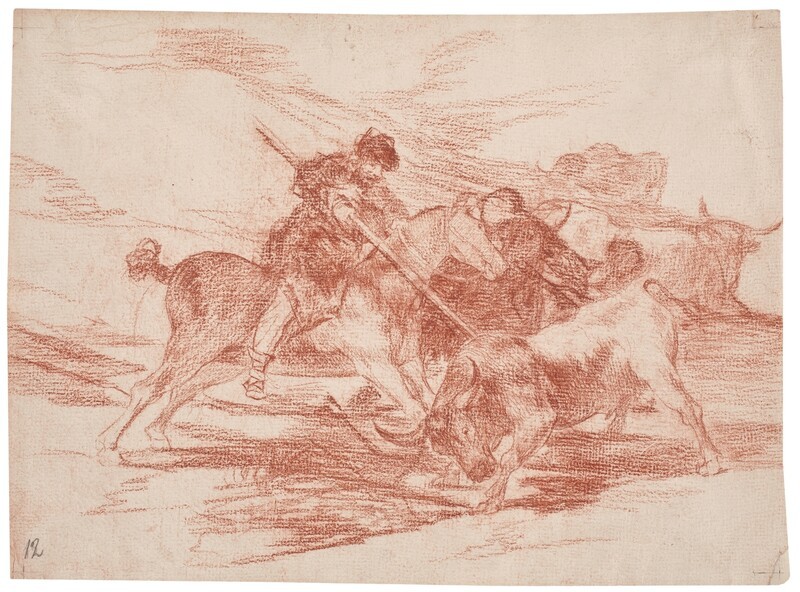- Cronología
- Ca. 1810 - 1815
- Ubicación
- The Prado National Museum. Madrid, Madrid, Spain
- Dimensiones
- 215 x 293 mm
- Técnica y soporte
- Sanguine on laid paper
- Reconocimiento de la autoría de Goya
- Documented work
- Titular
- El Prado National Museum
- Ficha: realización/revisión
- 16 Sep 2022 / 22 Jun 2023
- Inventario
- D4291
12 (in pencil; recto, lower left-hand corner)
[...]4 [On fragment of paper affixed] (verso, upper part)
1 (reverse)
210 (reverse, lower part)
245 [crossed out] (verso, lower part)
Unpublished (verso, upper part)
See How the ancient Spaniards hunted bulls on horseback in the countryside.
Javier Goya, Madrid, 1828; Mariano Goya, Madrid, 1854; Valentín Carderera, Madrid, c. 1861; Mariano Carderera, Madrid, 1880; Prado Museum, 1886.
In the preparatory drawing for How the ancient Spaniards hunted bulls on horseback in the countryside, Goya attempted to emphasise the primitive aspect of the scene through visual means with the very intelligent use of sophisticated formal resources that reinforce the sense of victims of human barbarity. The bestiality is emphasised by the rod with which the bull is immobilised, forcing him to lower his head and be submissive to the rider, by the primitive clothing made of animal skins and, above all, by the facial expression, with unkempt beards.
For this characterisation, Goya was inspired by Nicolás Fernández de Moratín's text Historical Letters on the Origin and Development of Bullfighting in Spain, 1777. The primitivism of the mimicry and gestures are complemented by lifeless, scenic landscapes, where clouds and shadows help to recreate the atmosphere of a bygone era.
As Matilla describes, the brutality evident in this first image of the series becomes an essential feature. In this sense, we can interpret this characterisation of its protagonist as a covert criticism of human savagery expressed through bullfighting. This is something that Goya had the opportunity to capture shortly before in his series of Disasters.
-
Milwakee1986cat. 31
-
Goya: toros y torerosEspace Van GoghArles1990displayed also at Academia de Bellas Artes de San Fernando, Madrid, consultant editor Pierre Gassier.cat. 14
-
Santander2017
-
Madrid2019cat. 153
-
Roma D.Anderson: Editeur1908pp. il. CVIII
-
1946pp. 179-187
-
MadridMuseo del Prado1954n. 152
-
ParísLe Club Français du Livre1963p. 38
-
Vie et ouvre de Francisco de GoyaParísOffice du livre1970pp. 276, n.1150
-
Barcelona1974pp. 9-10
-
Dibujos de Goya, 2 volsBarcelonaNoguer1975pp. 330-331
-
El mundo de Goya en sus dibujosMadridUrbión1979pp. 180-181
-
Goya, toros y torerosMadridMinisterio de Cultura, Comunidad de Madrid1990p. 84
-
MadridMuseo Nacional del Prado2001pp. 42-43
-
SantanderFundación Botín y Museo Nacional del Prado2017pp. 115 - 193
-
MadridMuseo Nacional del Prado2019p. 214

